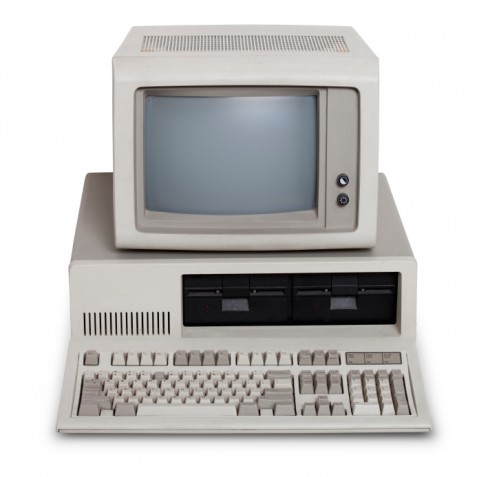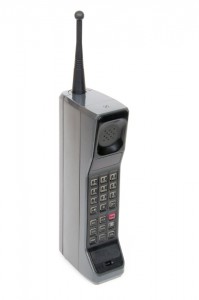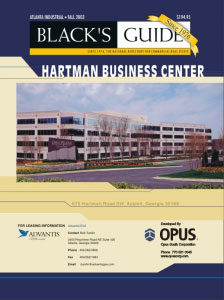I recently received a phone call that I get periodically from newbie commercial brokers asking for a few minutes of my time to inquire about the best technology to utilize in in commercial real estate brokerage. This got me to thinking about what the commercial real estate brokerage industry was like when I started in 1990, specifically what technology tools were commonly used at the time.
What was considered cutting edge at the time?
You can’t earn a commission with a computer!
Let’s start with the most obvious difference between today and 1990. Back in the day, CRE brokers didn’t use a personal computer. Hey, newbie CRE broker, can you imagine that? The prevailing school of thought among seasoned commercial real estate professionals was that a personal computer provided no value to CRE other than word processing for your secretary. Yes, secretary. That is what they called administrative assistants back in the day.
I remember the first time I asked about having a computer on my desk in my office. Yes, I had an office, and the answer I got was, “Son, you can’t make any money sitting behind your desk typing on a computer.”
Somewhere along the way, we finally got a computer on our desk, an e-mail address and a fax machine. And if you happened to pay someone big bucks to develop a company website, we started telling our clients how hi-tech we were.
Cell phones are for big hitters
In 1990, only the top producers owned a mobile phone, because they were the only ones who could afford one. In fact, most people called them car phones, and they were a clunky contraption in your automobile and not truly a mobile phone you could carry around in your hand or brief case.
Somewhere along in the 1990s as technology progressed, I purchased my first cell phone, and it was exactly that: a “phone” … and not a very good one at that.
Some agents back in the day even refused to purchase one as they became affordable, stating “Why would I ever want a client to call me anywhere but the office?” Hard to imagine this line of thinking in today’s connected smartphone world.
Market research was like art class
Today, CoStar Group is the 800 pound gorilla in the CRE tech world. Many brokers today like to complain about CoStar for various reasons. However, I remember what it was like to search for property and put together a market survey back in the day, and it was similar to an art class project from junior high — not the simple process of a few keystrokes on your laptop or iPad that it is today.
So, here is how you put together a market survey back in the day. Every quarter you received something in the mail (yes, the United States Postal Service) called a Black’s Guide, if you paid the money for one. It was a bound book of every office or industrial property in your market. And by default, when you received it, the property data was three months old. So you scanned through it by submarket and picked out the buildings you wanted to research for your client — based on their real estate requirements — and photocopied the page. Then you called every leasing agent to update the stale data so you had current market info. And this process sometimes took days depending on how many listing agents you had to call and how fast they called you back.
Once you had the correct and updated data, the process of putting the actual report began. This meant getting in your car to go and take a picture of the property (and mind you, nobody had a digital camera). Once you had taken all your crappy photos of the properties, you took your film to Walgreens to be developed. In the meantime, your secretary/assistant was preparing a building profile page on the word processor with the updated market data and big blank white space at the top to glue your building photo (once you had the photos back from Walgreens).
However, at this point, despite all the effort and hours of work, you were not finished. You still had to make a map of the properties included in your best-in-class market survey, and this is where your junior high art skills really came into play. This involved removing the relevant pages from your Key Map book and photocopying each page, then taping the photocopied pages together to make a map big enough to plot all the surveyed properties. Then you had these pages of scratch-off numbered dots that had to be put at the appropriate places on your high-quality map to represent the location of each property. Wow. Now with it finally finished, you then bound the survey, including your property profile pages and map, with this binding machine contraption.
The point here is the process of putting together a market survey (that today can be done in hours) took a week or more — and still looked like crap compared to today’s standards.
CRE tech is about efficiency
Today, many people in the CRE technology vertical like to throw around the term “disruption,” which in my opinion is mostly hogwash. Those that understand the business get that the best technology tools for CRE are those that bring new efficiency to the process of serving our clients. Years ago, CoStar and LoopNet introduced products to the marketplace that were successful in bringing new efficiency to the process of marketing and researching commercial real estate as well as presenting properties to our clients.
We are now seeing a plethora of new start-up companies aiming to bring new efficiency to various aspects of the commercial real estate brokerage business. So, my answer to the newbie broker asking what tools to use is those that bring new efficiency to your business and make you look more professional in the eyes of your clients. If history repeats itself — and this is likely to happen — the old-guard CRE broker will always initially resist new technology and then, as it proves it worth, quickly adopt the tools that do. Just remember you don’t have to wait until they say it’s OK.
Party like it’s 2019
I am old enough to remember when Prince released a hit song in 1982 called “1999.” The defining lyric was “Party like it’s 1999.” At the time, it seemed like a long time away. Yet, here were are. It’s almost 2015. I started in the CRE business in 1990, and these 24 years have gone by quickly. My goal today is the same as it was in 1999: to adopt the best CRE technology as fast as it comes to the market.
Coy Davidson is Senior Vice President of Colliers International in Houston. He publishes The Tenant Advisor blog.

 Coy Davidson
Coy Davidson





 Anjee Solanki
Anjee Solanki
 Colliers Insights Team
Colliers Insights Team
